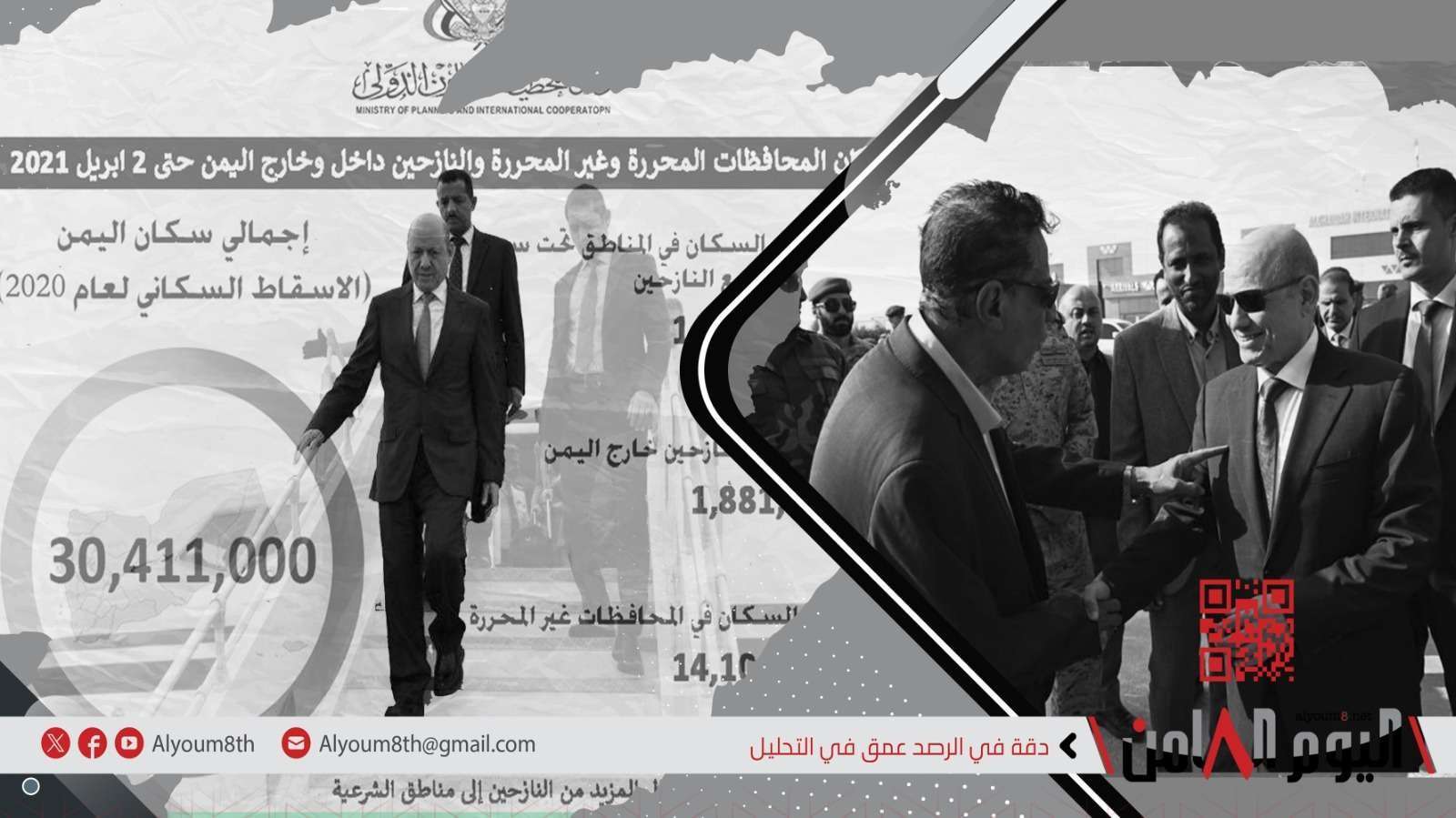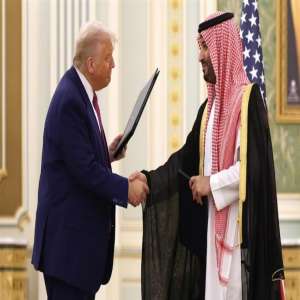..The displacement of 50,000 Yemenis since the beginning of 2023"
Saudi Arabia and the Yemen file... Efforts for sectarian sharing end Southerners' ambition to regain their former state
The United Nations International Organization for Migration announces the displacement of more than 4,700 Yemeni families since the beginning of this year 2023, towards the cities of the south, in a wave of displacement that may establish a sharing project on a sectarian basis that ends the aspirations of southerners to restore their former state, which was eliminated by a northern Yemeni war in the summer of 1994, less than three years after the signing of a fragile unity agreement between the two neighboring countries

The head of the Yemeni Interim Presidential Leadership Council, Rashad Al-Alimi, moves according to a regional agenda against the Southern Transitional Council – Archives
"Thanks and appreciation for the urgent humanitarian interventions of our brothers in the Kingdom of Saudi Arabia, who have always been on time by the side of the Yemeni people in various circumstances"; In these expressions of thanks, the head of the Yemeni Interim Presidential Leadership Council, Major General Rashad Al-Alimi, came out to talk about his repeated visit to Al-Mahra governorate, which has been fighting Riyadh for years to gain a foothold in the eastern governorate, and the "great neighbor of the south" does not mind achieving its ambitions, even at the expense of dividing the south, as southerners say.
On October 23, Alyoum8th newspaper published a report on the repeated visits of the Chairman of the Presidential Command Council, Rashad Al-Alimi, to Al-Mahra governorate, with the aim of obstructing the plans of the Southern Transitional Council, aimed at removing the Yemeni military forces that control Al-Mahra and the Hadramawt valley and desert, and their presence for Saudi Arabia has become "of great importance in achieving strategic goals, as Saudi Arabia believes that the removal of these forces from the southeastern governorates may hinder strategic projects that Riyadh has been working on since the era of the regime of Ali Abdullah." Saleh, and these projects have become sharp differences between Riyadh and Muscat, which also seeks to control Al-Mahra, through local arms in the governorate that now have armed formations outside the control of the local authority, and are even hostile to it.
Alyoum8th newspaper said in a previous report that what explains the Saudi interest in Al-Mahra, which has become an area of "influence dispute", is similar to barter, giving up the Saudi legacy in North Yemen since Sana'a was a kingdom before the sixties of the last century, in exchange for obtaining some privileges in Al-Mahra and Hadramawt in coordination with the Sultanate of Oman, or so interpreted the visit of the Saudi crown prince to Muscat.
Riyadh, which has not hidden its ambitions in Al-Mahra and Hadramawt for decades, is now moving in these provinces in a worrying way for southerners who are surprised that the neighboring kingdom stands against their aspirations to restore their former state, although they did well in the war against the Iranian proxies and were the only factor in expelling Iranian proxies from all southern cities.
Saudi Arabia is pursuing its strategic project of overlooking the Arabian Sea, but Riyadh knows that this will only be achieved in coordination and consultation with Muscat.
Regional ambitions in an important part of the south are no longer hidden, especially since Riyadh has overseen the formation of regional political entities aimed at opposing the Southern Transitional Council, which is confirmed by Saudi political elites, most notably Suleiman al-Aqili, who spoke to Saudi media about what he called the gains of intervention in the war "gaining influence in Al-Mahra, Hadramawt and Shabwa", which are strategic governorates for the STC.
Riyadh did not hide its desire to establish an oil port in Al-Mahra Governorate, as a southern outlet overlooking the Indian seamstress, away from any Iranian threats that Tehran may pose on the Strait of Hormuz, as the wealthy Kingdom has shown for decades its interest in the strategic southern governorates "Al-Mahra, Hadramawt and Shabwa", which is what Saudi Arabia is talking about naturally "talking about the possibility of annexing these governorates to the Saudi geography"; Or the south, it represents a safe and alternative route for exporting oil.
Despite the temporary calm during the past weeks, Riyadh has once again pushed its anti-STC cards, as it pushed Rashad Al-Alimi to visit Al-Mahra, followed by the exit of Riyadh's proxies in Hadramawt with statements described as malicious against the United Arab Emirates, which had withdrawn its forces from the south in late 2019.
A statement issued by Amr bin Habrish, a local official with ties to the Saudis, attacked that security measures carried out by the local authority in the province against elements outside the law and order represent a violation, holding the UAE responsible for the consequences of these measures.
Southern activists and politicians have expressed their rejection of these "irresponsible" statements, stressing Abu Dhabi's developmental role in Hadramawt and the south in general.
Riyadh was not satisfied with these positions in Hadramawt, but rushed to send Rashad Al-Alimi to the capital, Aden, where the population faces a major humanitarian crisis, represented by power outages for more than 20 hours a day, amid a major collapse of the local currency circulating against foreign currencies.
The Interim Presidential Council has not moved seriously in addressing these crises, but it is working according to a regional agenda aimed at reducing the influence of the Southern Transitional Council, towards re-confining it in Aden, and Saudi Arabia has formed local forces "personally affiliated with Rashad Al-Alimi, called the National Shield Forces, and Riyadh has already deployed some of those forces in southern cities, perhaps the most prominent presence of those forces at Al-Anad Air Base in Lahj Governorate.
Talking about the "Al-Anad base", the largest military base in the south has turned into a home for displaced Yemenis who left northern Yemen, which is under the control of the Houthis, in search of government support that arrives through international organizations, but the government of Maeen Abdul Malik did not hide the exploitation of the wave of Yemeni displacement towards the south, in strengthening its political presence in the scene through the crisis file posed by the displaced.
In recent days, the Southern Transitional Council (STC) suspended a conference of the government of Maeen Abdul Malik, which aimed to settle displaced Yemenis in southern cities, who are increasing significantly despite the cessation of hostilities and violence in areas of Yemen under the control of the Houthi and Muslim Brotherhood groups.
The International Organization for Migration of the United Nations announced on Monday the displacement of more than 4,700 Yemeni families since the beginning of this year 2023, from Yemeni governorates under the control of the Yemeni Brotherhood, such as Marib and Taiz, and other areas under the control of the Houthis in Tehama and Taiz as well, towards the cities of the south, in a step that establishes a sectarian sharing that ends the aspirations of southerners to restore their former state, which was eliminated by a northern Yemeni war in the summer of 1994, less than three years after the signing of a fragile unity agreement between The two neighboring countries.
The UN organization said in a report obtained by the German Press Agency (DPA), that "its displacement tracking unit monitored the displacement of 4,716 families in Yemen from the beginning of January until October 14 this year.
"These displaced families number 28,296 people who have been displaced at least once."
She pointed out that "the most governorates that witnessed displacement cases are Hodeida, Taiz and Marib," and according to UN estimates, the number of displaced Yemenis in the liberated southern cities reached "four million people"; while government statistics in Aden confirmed that the number of displaced people in the south reached more than eight million, meaning that their number has been equal to the original population.
The population of the south is about eight million people, while the number of displaced people reaches this number, and most of the wave of displacement was towards the governorates of Aden, Lahj, Abyan, Shabwa, Hadramawt and Al-Mahra, which compounded the humanitarian crises that southerners say are contrived.
A southern source and a former leader in the Southern Transitional Council confirmed that there are regional plans aimed at implementing a sharing project "on a sectarian basis", that North Yemen goes to the pro-Iranian Houthis, and the south becomes a "Sunni" Yemeni state, far from Shiite North Yemen, which completely destroys the project of southerners in restoring their former state.
The source warned of the consequences of allowing the realization of this project, stressing that the Southern Transitional Council has a great responsibility first in returning the displaced Yemenis to their areas from which they were displaced, especially in light of the existence of a long-term truce that actually began at the beginning of 2022, and there is no longer any desire for all parties to the conflict in Yemen to renew the fighting, but there is a kind of rapprochement between these parties.




الحوطة